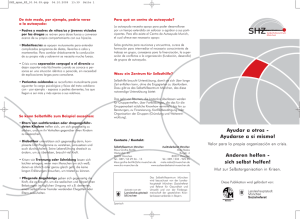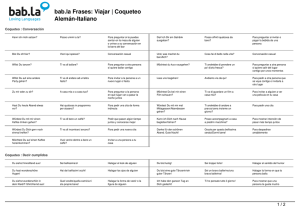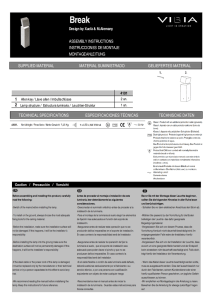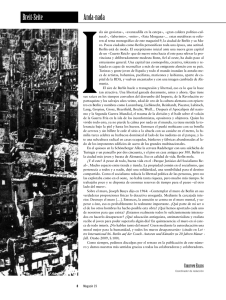RECOMENDACIONES ¡NUNCA OLVIDE! BITTE NIEMALS
Anuncio
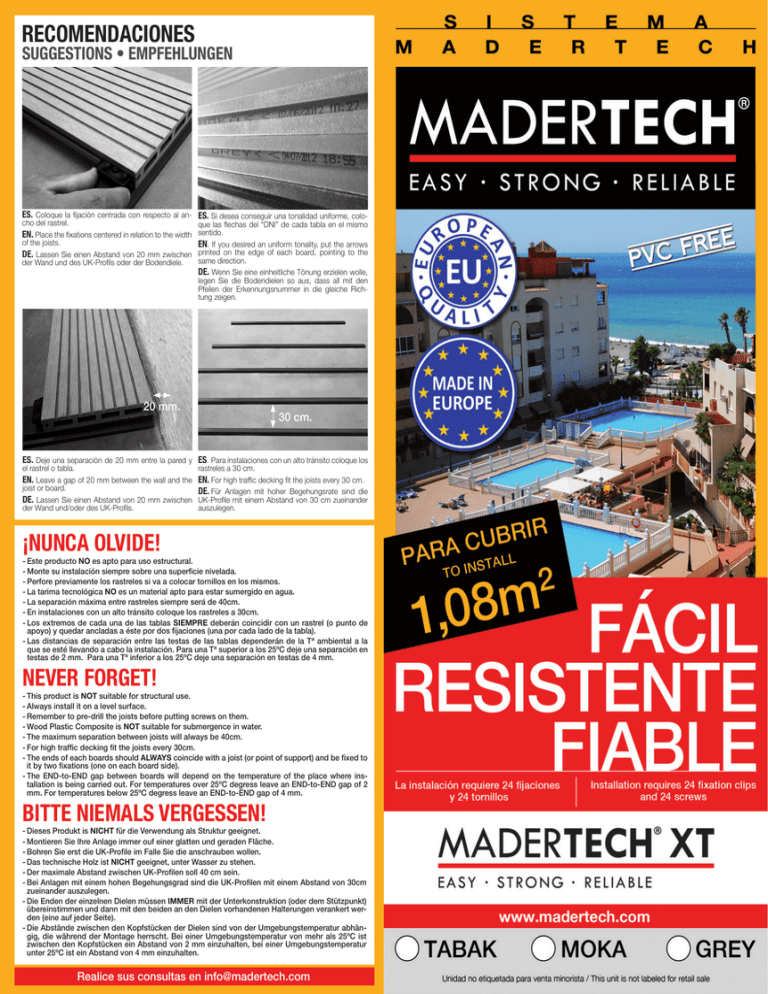
RECOMENDACIONES SUGGESTIONS • EMPFEHLUNGEN ES. Coloque la fijación centrada con respecto al an- ES. Si desea conseguir una tonalidad uniforme, colocho del rastrel. EN. Place the fixations centered in relation to the width of the joists. DE. Lassen Sie einen Abstand von 20 mm zwischen der Wand und des UK-Profils oder der Bodendiele. que las flechas del “DNI” de cada tabla en el mismo sentido. EN. If you desired an uniform tonality, put the arrows printed on the edge of each board, pointing to the same direction. DE. Wenn Sie eine einheitliche Tönung erzielen wolle, legen Sie die Bodendielen so aus, dass all mit den Pfeilen der Erkennungsnummer in die gleiche Richtung zeigen. 20 mm. 30 cm. ES. Deje una separación de 20 mm entre la pared y ES. Para instalaciones con un alto tránsito coloque los el rastrel o tabla. EN. Leave a gap of 20 mm between the wall and the joist or board. DE. Lassen Sie einen Abstand von 20 mm zwischen der Wand und/oder des UK-Profils. rastreles a 30 cm. EN.For high traffic decking fit the joists every 30 cm. DE.Für Anlagen mit hoher Begehungsrate sind die UK-Profile mit einem Abstand von 30 cm zueinander auszulegen. ¡NUNCA OLVIDE! -Este producto NO es apto para uso estructural. -Monte su instalación siempre sobre una superficie nivelada. -Perfore previamente los rastreles si va a colocar tornillos en los mismos. -La tarima tecnológica NO es un material apto para estar sumergido en agua. -La separación máxima entre rastreles siempre será de 40cm. -En instalaciones con un alto tránsito coloque los rastreles a 30cm. -Los extremos de cada una de las tablas SIEMPRE deberán coincidir con un rastrel (o punto de apoyo) y quedar ancladas a éste por dos fijaciones (una por cada lado de la tabla). -Las distancias de separación entre las testas de las tablas dependerán de la Tª ambiental a la que se esté llevando a cabo la instalación. Para una Tª superior a los 25ºC deje una separación en testas de 2 mm. Para una Tª inferior a los 25ºC deje una separación en testas de 4 mm. NEVER FORGET! -This product is NOT suitable for structural use. -Always install it on a level surface. -Remember to pre-drill the joists before putting screws on them. -Wood Plastic Composite is NOT suitable for submergence in water. -The maximum separation between joists will always be 40cm. -For high traffic decking fit the joists every 30cm. -The ends of each boards should ALWAYS coincide with a joist (or point of support) and be fixed to it by two fixations (one on each board side). -The END-to-END gap between boards will depend on the temperature of the place where ins­ tallation is being carried out. For temperatures over 25ºC degress leave an END-to-END gap of 2 mm. For temperatures below 25ºC degress leave an END-to-END gap of 4 mm. BITTE NIEMALS VERGESSEN! -Dieses Produkt is NICHT für die Verwendung als Struktur geeignet. -Montieren Sie Ihre Anlage immer ouf einer glatten und geraden Fläche. -Bohren Sie erst die UK-Profile im Falle Sie die anschrauben wollen. -Das technische Holz ist NICHT geeignet, unter Wasser zu stehen. -Der maximale Abstand zwischen UK-Profilen soll 40 cm sein. -Bei Anlagen mit einem hohen Begehungsgrad sind die UK-Profilen mit einem Abstand von 30cm zueinander auszulegen. -Die Enden der einzelnen Dielen müssen IMMER mit der Unterkonstruktion (oder dem Stützpunkt) übereinstimmen und dann mit den beiden an den Dielen vorhandenen Halterungen verankert werden (eine auf jeder Seite). -Die Abstände zwischen den Kopfstücken der Dielen sind von der Umgebungstemperatur abhängig, die während der Montage herrscht. Bei einer Umgebungstemperatur von mehr als 25ºC ist zwischen den Kopfstücken ein Abstand von 2 mm einzuhalten, bei einer Umgebungstemperatur unter 25ºC ist ein Abstand von 4 mm einzuhalten. Realice sus consultas en [email protected] MANUAL DE ESPAÑOL 1 COLOCACIÓN DE LOS RASTRELES La orientación de los rastreles debe respetar la pendiente de desagüe. Si no fuese así los rastreles se deberán levantar con cuñas niveladoras para permitir el escurrido natural del agua. Si fuese necesario fijar el rastrel al suelo, taládrelo antes de colocar el taco. Recuerde mantener una distancia de 15 mm entre las cabezas de los rastreles. Sitúe los rastreles a 40 cm entre sí como máximo. INSTALACIÓN INSTALLATION MANUAL • MONTAGEANLEITUNG 1 2 2 INICIO DE LA INSTALACIÓN Atornille la fijación de inicio. Asegúrese de colocar el tornillo en el centro del rastrel. En caso de comenzar sobre una pared o cualquier elemento vertical, deje una separación de 20 mm con ella. 3 CONTINÚE CON SU INSTALACIÓN Tras haber fijado la primera tabla, posicione las fijaciones centrales (3a) y sin atornillar coloque la segunda tabla (3b). Una vez hecho esto, ajuste la segunda tabla y proceda a atornillar las fijaciones sobre el rastrel (3c). Es importante que la fijación central entre bien en la ranura lateral de la tabla para lograr una distancia entre las tablas de 6 mm. Repita la operación para el resto de las tablas. 40 cm. 3 a 3 b 3 c 5 a 4 a 4 DISTANCIA ENTRE TESTAS A la hora de realizar la instalación, tenga en cuenta que para Tª ambientales superiores a los 25ºC deje una distancia entre las testas de las tablas de 2 mm. Si la Tª ambiental es inferior a los 25ºC deje una distancia entre las testas de las tablas de 4 mm. 5 COLOCACIÓN DE LA ÚLTIMA TABLA Al llegar al final de la instalación, corte la última tabla según sea necesario y péguela a los rastreles con masilla adhesiva elástica (5a). También puede atornillarla (5b) para lo cual deberá emplear tornillos de acero inoxidable de 3,5 x 35 mm que hará coincidir con el nervio del perfil (5c). En este último caso, por seguridad y para darle una mejor terminación, se recomienda avellanar la entrada del tornillo para que la cabeza de éste quede al mismo nivel de la instalación. 6 COLOCACIÓN DEL RODAPIÉ Cuando el rodapié vaya perpendicular al rastrel, éste deberá ir atornillado a la tabla (6a) y debe coinci­dir con la ranura central del lateral. En el caso de que el roda­pié vaya paralelo al rastrel, ésta deberá ir atornillado al rastrel (6b) y debe coincidir con el centro del mismo. Uti­lice un tornillo de 3,0 x 35 mm para estos casos. Tam­bién puede utilizar masilla adhesiva elástica sobre el rastrel y el perfil para pegar el rodapié. Para facilitar el montaje, se sugiere la presentación del rodapié con masilla adhesiva elástica. ¡IMPORTANTE! En caso de atornillar, mantenga una distancia mínima de 5 cm desde el vértice del rodapié (6c). 4 mm. 4 b 2 mm. 5 b 5 c 7 COLOCACIÓN DEL RODAPIÉ CUANDO QUEREMOS SALVAR UN ÁNGULO El rodapié es flexible en frío, no obstante recomendamos colocarla al sol para mejorar sus propiedades de flexibilidad. Dado que el rodapié está sometido a un esfuerzo mayor, recomendamos colocar dos tornillos al inicio y al final del rodapié*. (*) No colocar tornillo en la curva del rodapié. 8 El arco de circunferencia máximo que admite el rodapié es de 30 cm. ENGLISH 6 a 6 b 6 c 5 mm. 7 8 30 cm. 1 LAYING THE JOISTS The direction of the joists must follow the drainage slope. On flat surfaces, the joists must be lifted with levelling wedges to enable natural water runoff. If the joist has to be fixed to the surface, drill it before inserting the plug. Remember to keep a distance of 15 mm between the heads of the joists. Lay the joists no more than 40 cm apart. 2 STARTING THE INSTALLATION Screw in the start fixing. Make sure you drive the screw into the centre of the joist. If starting near a wall or any other vertical element, leave a gap of 20 mm between it and the start fixing. 3 NEXT STEP After fixing the first board, put the central fixations (3a) and, without screw them, put the second board (3b). Once this is done, adjust the second board and screw the fixations into the joist (3c). It is important that the central fixation be fitted properly into the side groove of the board so that the distance between the boards is 6 mm. Repeat these steps for the other boards. 4 END-TO-END GAP During installation, if the ambient temperature is over 25ºC degress leave and END-to-END gap of 2 mm. If the ambient temperature is below 25ºC degress leave an END-to-END gap between of 4 mm. 5 FITTING THE LAST BOARD On reaching the end of the installation, fix it to the joists with elastic ad­hesive putty (5a). You can also screw the last board to the joist (5b). So you have to use 3,0 diameter x 35 mm length stainless steel screws. Make them coincide with the centre of the profile ribs (5c). In this last case, for safety and to give a better finish, it is recommended to countersink the profile to help to the screw to enter and leave it at the same level of installation. 6 FITTING THE SKIRTING BOARD When the skirting board is perpendicular to the joist, it should be screwed into the side of the board (6a) (in line with the central groove) and if the skirting board lies parallel to the joist, it should be screwed into the side of the joist (6b) (in line with the joist´s centre). In this case use a 3,0 diameter x 35 mm length stainless steel screw. You also can apply elastic adhesive putty to both the joist and the profile to fix the skirting board. To make ins­tallation easier, we suggest applying elastic adhesive putty before screw it to the joist. IMPORTANT! If you prefer to use screws, keep a distance of at least 5 cm from the apex of the skirting board (6c). 7 FIXING THE SKIRTING BOARD AT AN ANGLE Although skirting board are flexible when cold, we would recommend leaving them under sunlight exposure before installing to make them even more pliable. Fixing the skirting board at an angle put it under more strain. We would therefore recommend using two screws at the beginning and end of each piece of skirting board when using it at an angle*. (*) Do not use screws on the curve of the skirting board. 8 The skirting board are designed to take a maximum curve of radius = 30 cm. DEUSTCH 1 AUFBRINGEN DER UK-PROFILE Die Ausrichtung der UK-Profile muss die Wasserablau­ fsneigung einhalten. Anderfalls müssen die UK-Profile mit Keilschuhen gehoben werden, um das natürliche Ablaufen des Wassers zu ermöglichen. Falls erforder­ lich, ist der UK-Profil am Boden zu befestigen. Bitte bohren Sie die Löcher vor Anbringung des Dübels. Beachten Sie, dass zwischen den Kopfstücken der UK-Profilen ein Abstand von 15 mm einzuhalten ist. Bringen Sie die UK-Profile mit einem Abstand von hö­ chstens 40 cm zueinander an. 2 BEGINN DER MONTAGE Schrauben Sie die Mittigen Halterung an. Versichern Sie sich, die Schraube in der Mitte des UK-Profils an­ zubringen. Falls Sie auf einer Wand oder auf anderen senkrechten Elementen beginnen, ist ein Abstand von 20 mm zur Wand herzustellen. 3 ANBRINGUNG DER MITTIGEN HALTERUNG Nach Anbringung der ersten Diele sind die mittigen Befestigungen in Stellung zu bringen (3a). Legen Sie dann die zweite Diele auf, ohne sie anzuschrauben (3b). Da­nach richten Sie die zweite Diele aus und schrauben die Halterungen auf dem UK-Profil fest (3c). Es ist wichtig, dass die mittige Halterung gut in die seitliche Rille passt, um zwischen den Dielen einen Abstand von 6 mm zu erreichen. Verfahren Sie in gleicher Weise mit allen weiteren Dielenbrettern. 4 ABSTÄNDE ZWISCHEN DEN KOPFSTÜCKEN DER DIELEN Bei einer Umgebungstemperatur von mehr als 25ºC ist zwischen den Kopfstücken ein Abstand von 2 mm ein­zuhalten, bei einer Umgebungstemperatur unter 25ºC ist ein Abstand von 4 mm einzuhalten. 5 AUFBRINGEN DER LETZEN BODENDIEL Bei Beendigung der Montage ist die letzte Diele so zurechtzuschneiden, wie es nötig ist, und danach ist es mit elastischer Klebemasse auf die UK-Profile zu kleben (5a). Sie kann auch verschraubt werden (5b). Dafür sollten Sie Schrauben mit 3,5 x 40 mm benutzen und mit dem Dielennerv übereinstimmen lassen (5c). 6 ANBRINGUNG DER SEITLICHEN SOCKE­ LLEISTE Sobald die Seitenblende quer zum UK-Profil angebracht worden ist, ist diese an der Seite des Die­lenbretts anzuschrauben (6a)und sie muss dabei mit seiner mittigen Rille übereinstimmen. Falls aber die Seitenblende parallel zum UK-Profil verläuft, ist sie an der Seite des UK-Profils anzuschrauben (6b) und in Übereinstimmung mit seinem Mittelpunkt. Beim Verschrauben ist in diesem Falle eine Schraube mit 3,0 x 35 mm zu verwenden. Sie können auch elastischen Klebstoff auf dem UK-Profil und der Diele benutzen, um die Seitenblende festzukleben. Um die Montage zu erleichtern wird empfohlen, die Seitenblende in der Darreichungs­ form mit elastischer Klemebasse zu verwenden. WICHTIG!: Beim Verschrauben ist ein Mindes­tabstand von 5cm vom Scheitelpunkt der Seiten­blende ab einzuhalten (6c). 7 ANBRINGUNG DER SOCKELLEISTE, WENN EIN WINKEL ZU ÜBERWINDEN IST Die Sockelleiste ist kalt biegsam, aber wir empfehlen, sie bei Sonnenschein anzubringen, um ihre Biegeei­ genschaften zu verbessern. Da die Sockelleiste einer größeren Belastung ausgesetzt ist, empfehlen wir, am Anfang und am Ende der Sockelleiste zwei Schrauben anzubringen*. (*) Bitte keine Schrauben in der Kurve der Sockelleiste anbrin­gen. 8 Die Sockelleiste kann einen Außenbogen von bis zu 30 cm aushalten.
